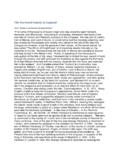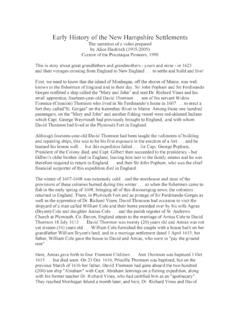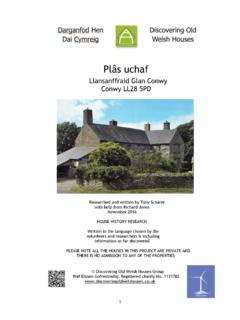Transcription of The History of Barnardo’s
1 The History of barnardo s 1845-1905 The work of thomas barnardo . When thomas John barnardo was born in Dublin in 1845 no one could have predicted that he would become one of the most famous men in Victorian Britain. At the age of 16, after converting to Protestant evangelicalism he decided to become a medical missionary in China and so set out for London to train as a doctor. The London in which thomas barnardo arrived in 1866 was a city struggling to cope with the effects of the Industrial Revolution. The population had dramatically increased and much of this increase was concentrated in the East End, where overcrowding, bad housing, unemployment, poverty and disease were rife. A few months after thomas barnardo came to London an outbreak of cholera swept through the East End killing more than 3,000 people and leaving families destitute.
2 Thousands of children slept on the streets and many others were forced to beg after being maimed in factories. In 1867, thomas barnardo set up a ragged school in the East End, where poor children could get a basic education. One evening a boy at the Mission, Jim Jarvis, took thomas barnardo around the East End showing him children sleeping on roofs and in gutters. The encounter so affected him he decided to devote himself to helping destitute children. In 1870, barnardo opened his first home for boys in Stepney Causeway. He regularly went out at night into the slum district to find destitute boys. One evening, an 11-year old boy, John Somers (nicknamed 'Carrots') was turned away because the shelter was full. He was found dead two days later from malnutrition and exposure and from then on the home bore the sign 'No Destitute Child Ever Refused Admission'. Victorians saw poverty as shameful as a result of laziness or vice.
3 However thomas barnardo accepted all children and stressed that every child deserved the best possible start in life, whatever their background - a philosophy that still inspires the charity today. barnardo later opened the Girls' Village Home in Barkingside, a collection of cottages around a green, which housed 1,500 girls. By the time a child left barnardo 's they were able to make their own way in the world - the girls were equipped with domestic skills and the boys learnt a craft or trade. thomas barnardo strongly believed that families were the best place to bring up children and he established the first fostering scheme when he boarded out children to respectable families in the country. He also introduced a scheme to board out babies of unmarried mothers. The mother went into service nearby and could see her child during her time off. 1905-1939 The charity after thomas barnardo s death By the time thomas barnardo died in 1905, the charity he founded ran 96 homes caring for more than 8,500 children.
4 Residential care emphasised children's physical and moral welfare rather than their emotional wellbeing. Some homes housed hundreds of children and staff were sometimes harsh and distant. Many adults who grew up in the homes look back with affection and believe the charity was a true family. Others remember loneliness, bullying and even abuse. Child emigration was extended to Australia after the First World War as it was still seen as an appropriate response to the social problems of the day, even if by today's standards the practice seems cruel. These ideas continued largely unchallenged until after the Second World War when the emphasis shifted towards keeping children and their families together in the community. 1945- 1960 The charity after the War The war marked a turning point in barnardo 's development and the History of childcare in the UK.
5 Evacuation brought 'charity children' and 'ordinary' middle and upper class families into contact with each other and they gained a greater understanding of their circumstances. The disruption of war also improved understanding of the impact of family break ups and effects on children brought up away from home. Then in 1946, a national report (The Curtis Report) on children 'deprived of a normal home life' was published, prompting a revolution in childcare. For the first time, children were acknowledged as the nation's responsibility. This report paved the way for the Children's Act of 1948, which placed the duty of caring for homeless children and those in need on local authorities. So, during the 1940's and 1950's barnardo 's began working more closely with families. The charity awarded grants to families in difficulties because the breadwinner was unable to work due to illness or an accident.
6 In the mid 1950's it developed a scheme to house whole families affected by ill health, housing problems, unemployment and crime. By the end of the decade almost a quarter of the charity's work involved helping children to stay with their own families. 1960-1999 Changing times The 1960s were a time of radical change for barnardo 's. Single parenthood was becoming more acceptable; greater use of contraception meant that there were fewer unwanted children and improved social security benefits meant that it was no longer necessary for parents to hand over their children to barnardo 's because they could not afford to care for them. These developments and the changes in legislation meant that the number of children received by barnardo 's was decreasing and so a commitment was made to cut down on residential services and develop new work with disabled children and those with emotional and behavioural problems.
7 To reflect this, the charity changed its name in 1966 from Dr barnardo 's Homes to Dr barnardo 's. By the end of the decade plans were made to close down large numbers of homes and to convert them into specialist units. In the 1990s, society became aware, through a number of high profile criminal investigations and public enquiries, that a significant number of children in residential care homes in the UK during the last century were victims of physical and sexual abuse, neglect and discrimination. Some of those children were among the 350,000 cared for in barnardo 's homes between the 1870s and 1980s. barnardo 's deeply regrets the maltreatment which some children suffered. Where allegations of abuse are brought to our attention, barnardo 's immediately informs the police and co-operates fully in any subsequent investigation. Our Making Connections service specialises in providing those who were in barnardo 's care with access to their records, and offering support to those trying to come to terms with their past - particularly those going through a process of disclosure of abuse.
8 Today we know how institutional care can rarely be a substitute for a proper family life, hence our shift of focus to working with families and communities. But, in the circumstances of the time, we believe that the vast majority of those in barnardo 's care had a more positive experience and received a better preparation for life than they would have done without the part that barnardo 's played in their lives. From the 1970s onwards, barnardo 's continued to expand its work in fostering and adoption, and family centres were set up in communities to support families in deprived areas. They set out to help families facing problems such as unemployment, poor health, bad housing and poverty, with the aim of defusing the stress and tension that might lead to family breakdown and child abuse. In 1988 the organisation changed its name from Dr barnardo 's to barnardo 's to reflect the contrast with its Victorian past.
9 The last traditional-style home closed in 1989. barnardo 's pioneered schemes for young juveniles and disabled children and throughout the 1980s and 1990s developed new areas of work in response to public concern over issues such as child sexual abuse, homelessness and children affected by HIV/AIDS. 21st Century What barnardo s does now Today we continue thomas barnardo s work and barnardo s is a leading children's charity working directly with over 110,000 children, young people and their families every year. Today, we run 394 vital projects across the UK to help some of the most vulnerable children and young people believe in themselves. Our projects work with lots of issues; from family drug misuse to disability; from youth crime to mental health; from sexual abuse to domestic violence. barnardo s believes we can bring out the best in every child, and that all children deserve the chance to fulfil their potential.
10 We use our expertise and knowledge to campaign for better care for children, and to champion the rights of every child. We also run award winning advertising campaigns to help us spread the word about vulnerable children. Find out more at
















